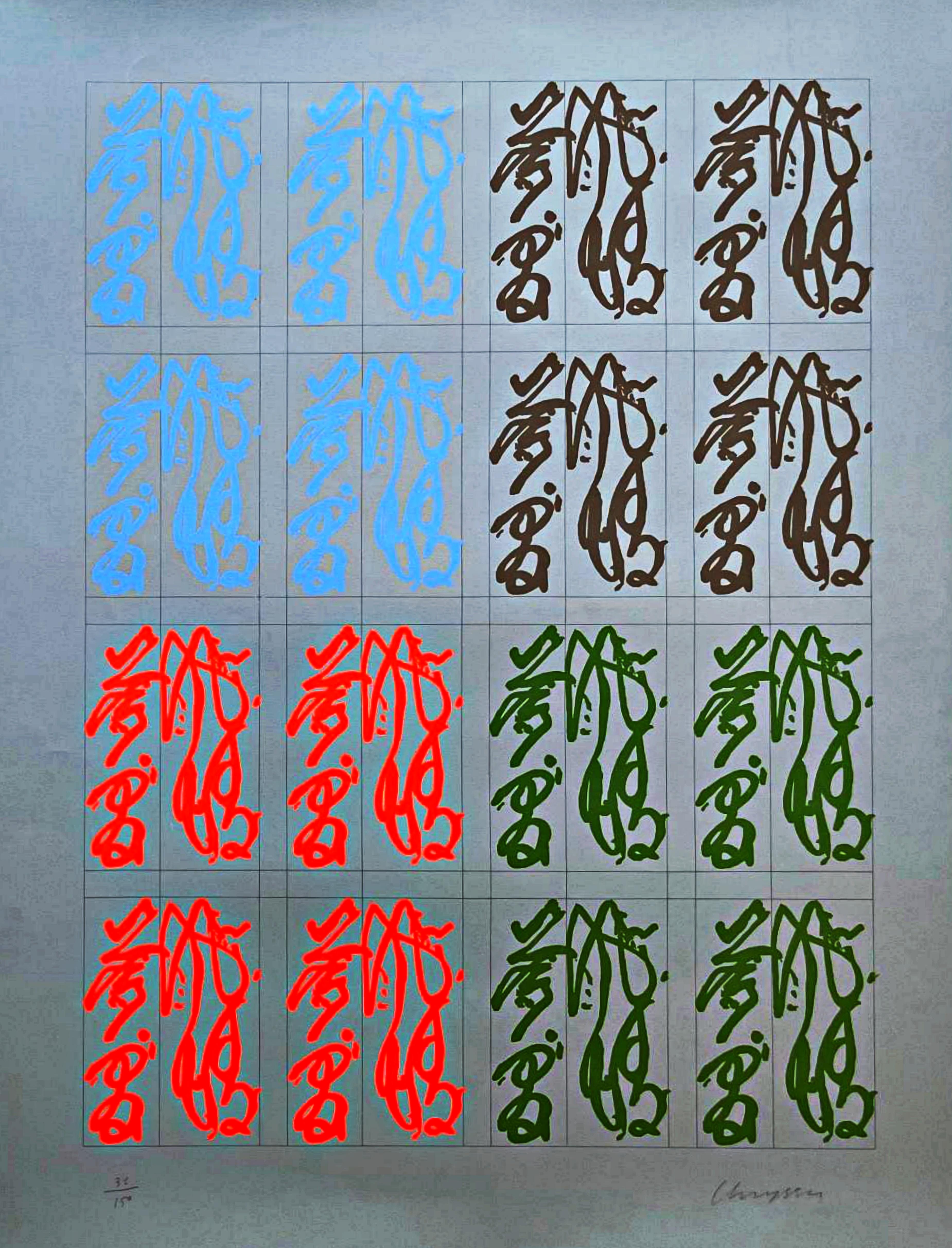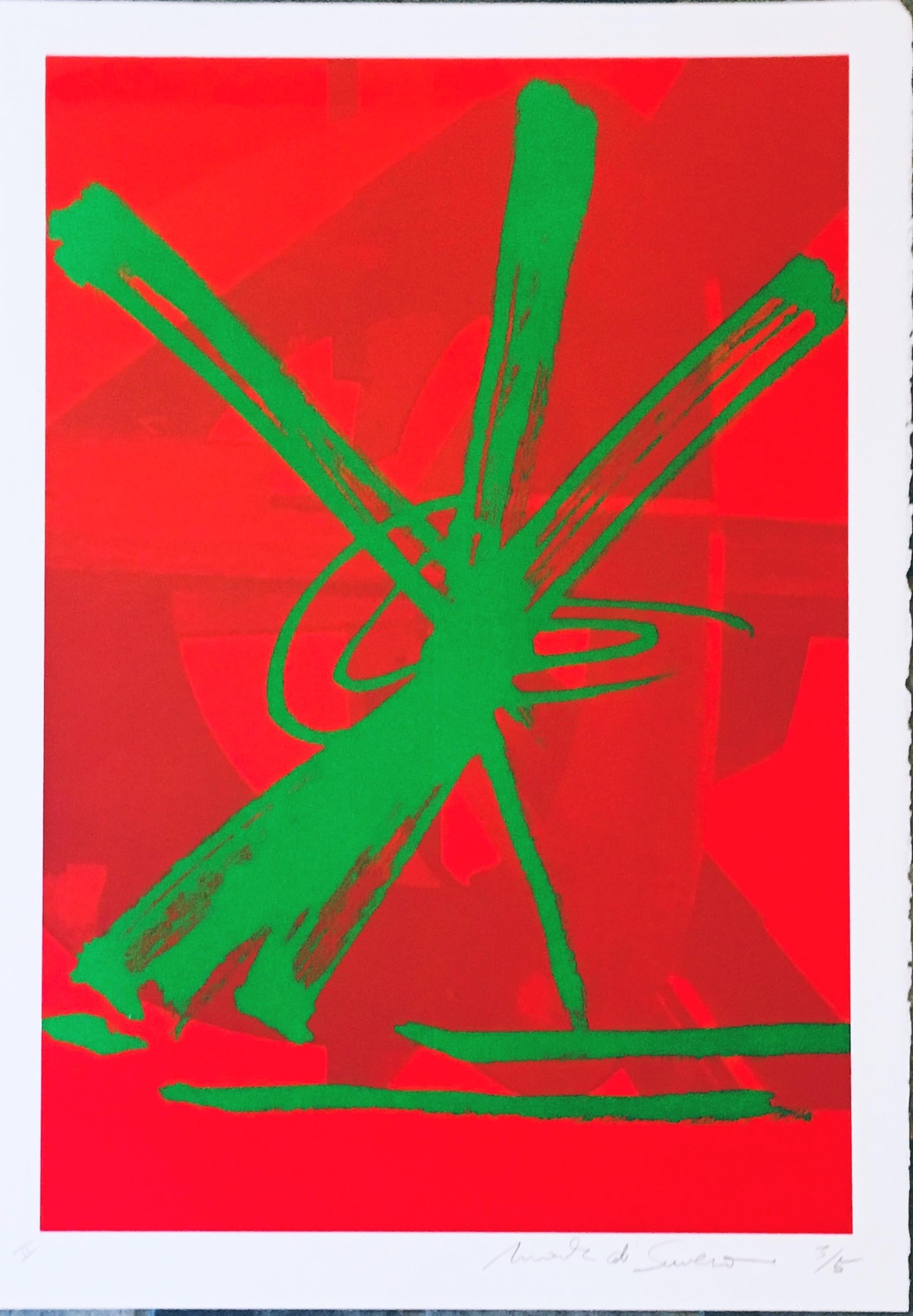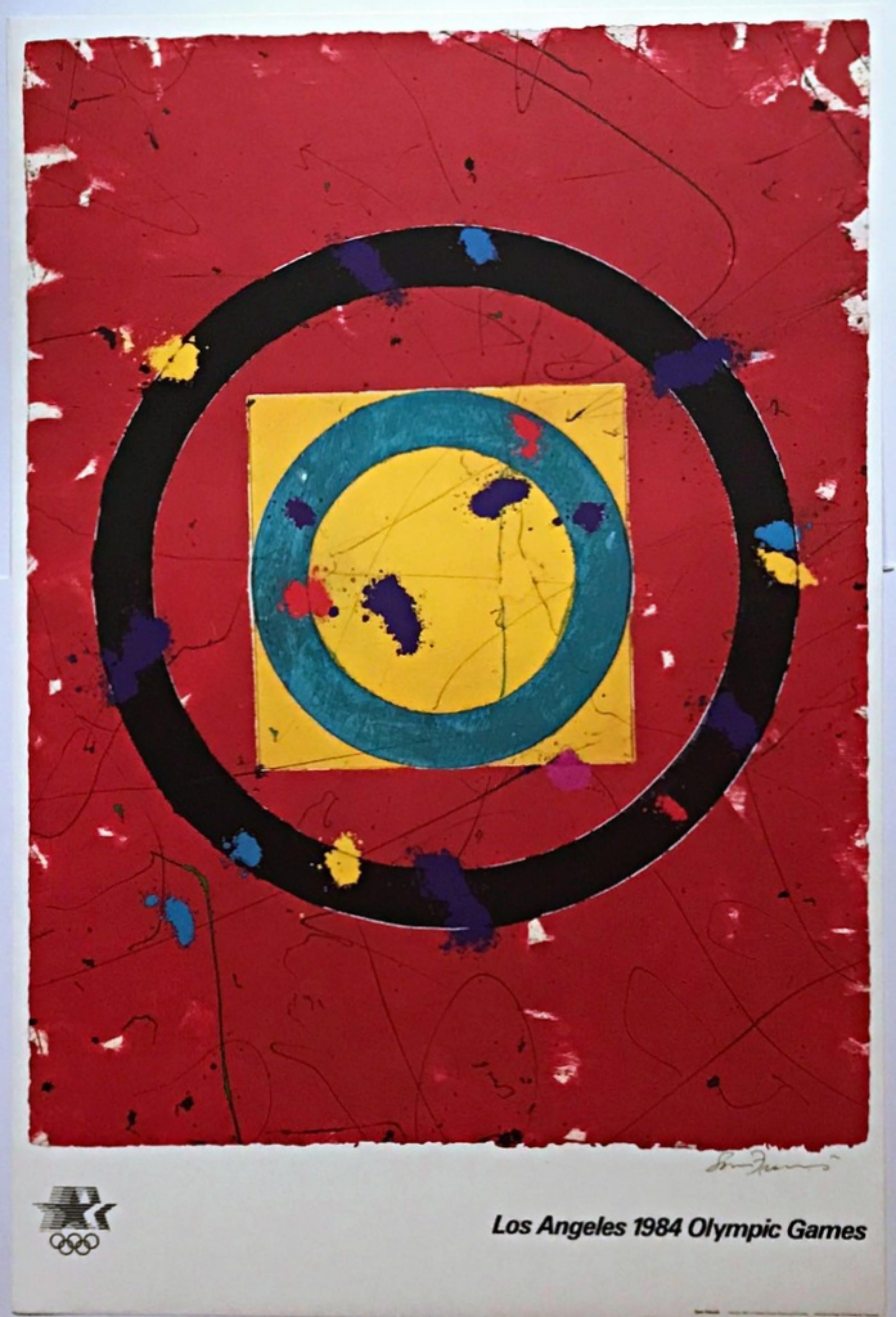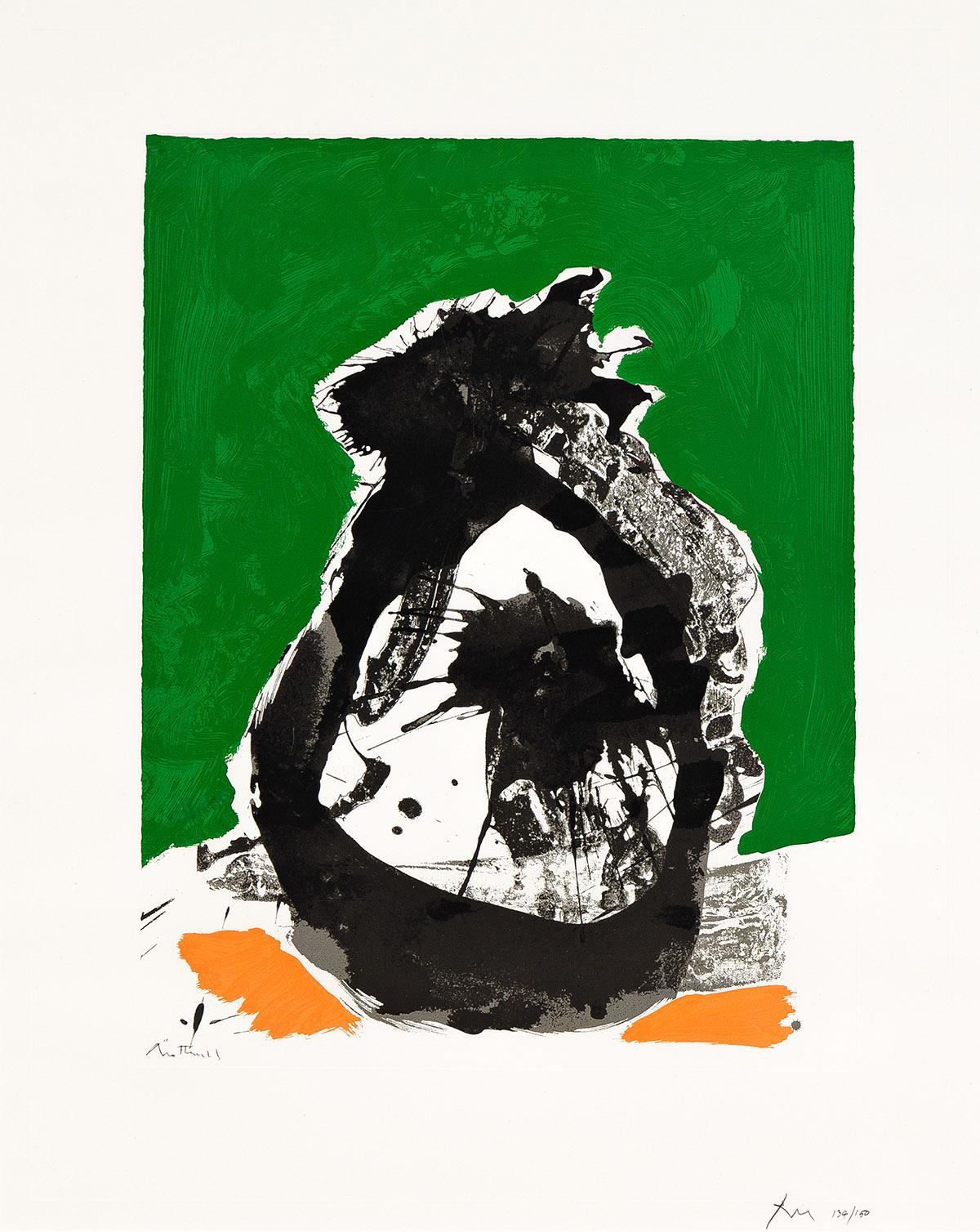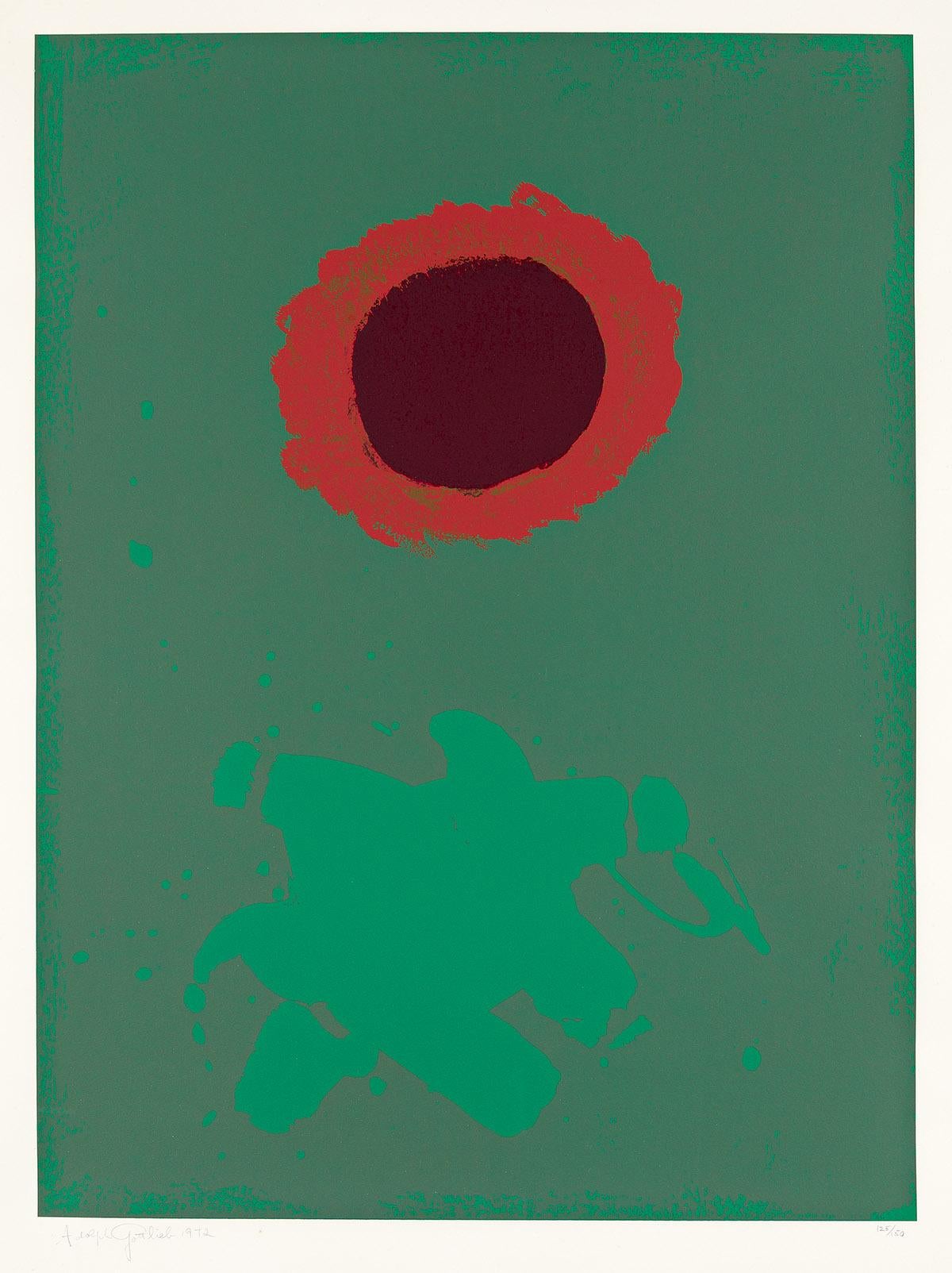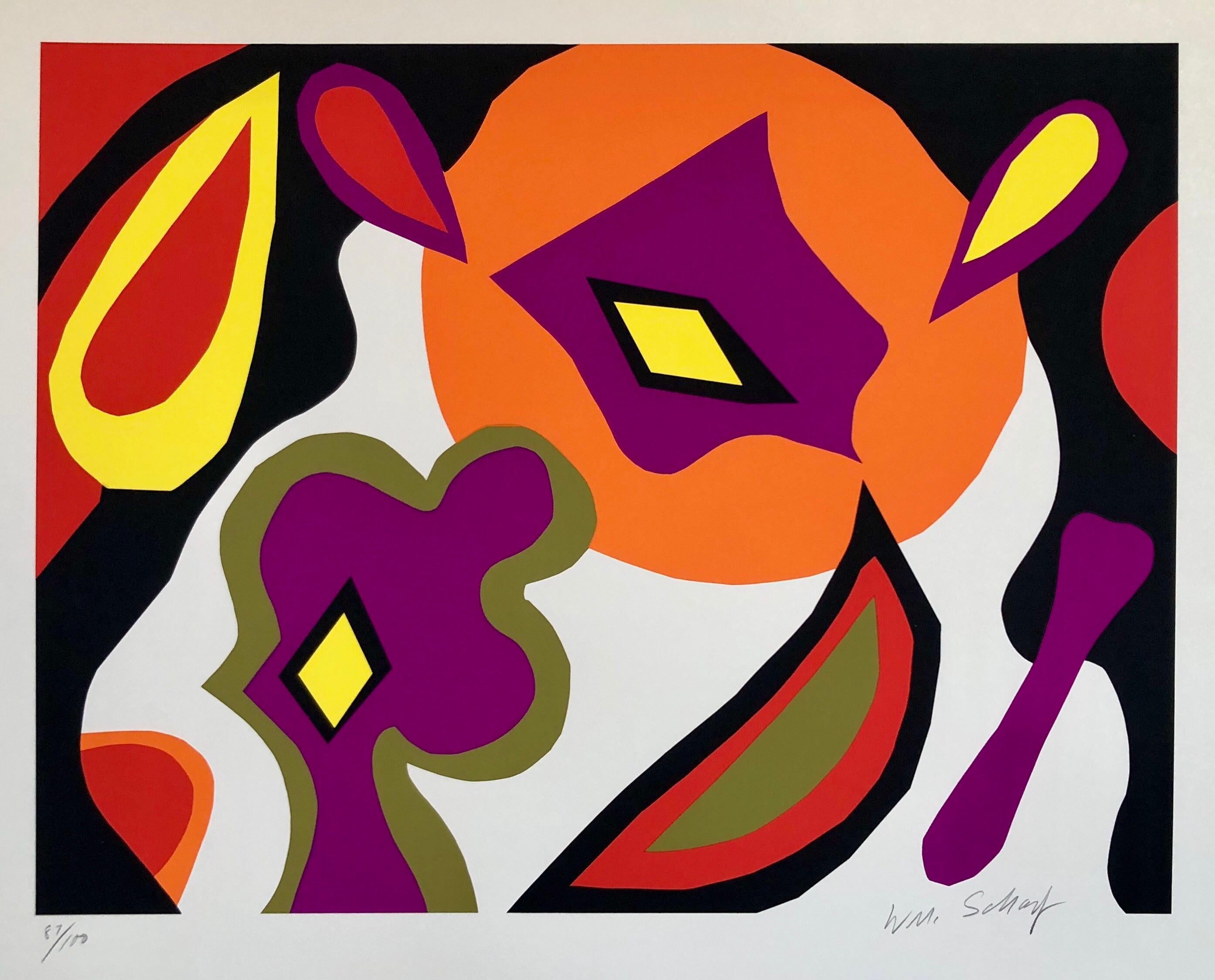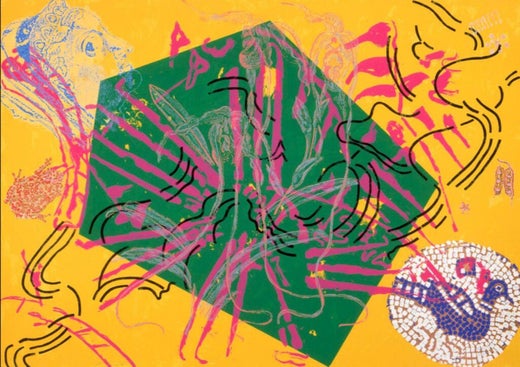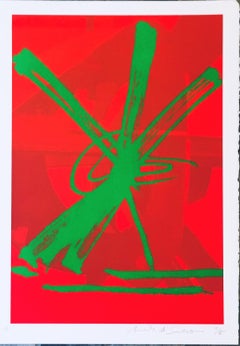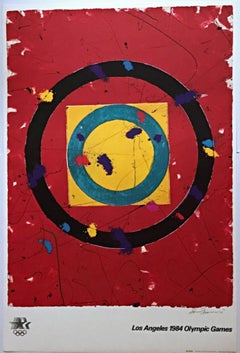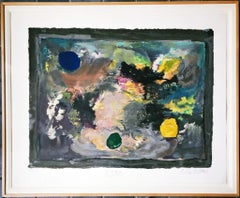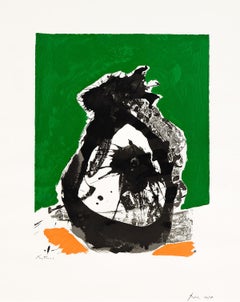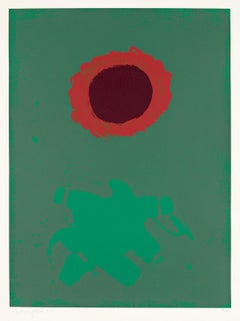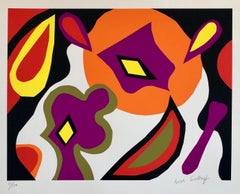Items Similar to 5745, for the Jewish Museum original signed/n abstract expressionist screenprint
Want more images or videos?
Request additional images or videos from the seller
1 of 6
Nancy Graves5745, for the Jewish Museum original signed/n abstract expressionist screenprint1984
1984
About the Item
Nancy Graves
5745, for the Jewish Museum, 1984
Silkscreen on paper
Signed, numbered 5/90 and dated in graphite pencil on the front; bears publishers' blind stamp front left corner
30 1/4 × 40 1/2 inches
Unframed
Commissioned by the Mr. and Mrs. Albert A. List Graphic Fund for The Jewish Museum, New York
Signed, numbered and dated in graphite pencil on the front; bears publishers' blind stamp front left corner. Commissioned by the Mr. and Mrs. Albert A. List New Year's Graphic Fund for The Jewish Museum, New York. During the 1980s, various artists were commissioned to create a print celebrating the Jewish New Year. This is the silkscreen renowned sculptor Nancy Graves created to celebrate the year 5745 of the Jewish Calendar, beginning in September 1984 (Rosh Hashanah). This work was published in a limited edition of 90. The number 90 has special significance in Jewish gamatria (numerology) for several reasons, including the fact that it equals five times life - or Chai. The number for Chai, meaning "Life " s 18, and 18 x 5 = 90. This is a magical number in Judaism. All of the works were published in editions that were multiples of 18, or the Life. In her lifetime, Nancy Graves did not receive the renown or acknowledgement that her ex-husband and former Yale School of Art classmate Richard Serra did, but she is finally getting the recognition she richly deserves.
Biography: Nancy Graves (1939 – 1995) is an American artist of international renown. A prolific cross-disciplinary artist, Graves developed a sustained body of sculptures, paintings, drawings, watercolors, and prints. She also produced five avant-garde films and created innovative set designs.
Born in Pittsfield Massachusetts, Graves graduated from Vassar College in 1961. She then earned an MFA in painting at Yale University in 1964, where her classmates included Robert Mangold, Rackstraw Downes, Brice Marden, Chuck Close, as well as Richard Serra with whom she was married from 1964 to 1970. Five years after graduating, her career was launched in 1969 when she was the youngest artist — and only the fifth woman — to be selected for a solo presentation at the Whitney Museum of Art. Graves’ work was subsequently featured in hundreds of museum and gallery exhibitions worldwide, including several solo museum exhibitions. She was awarded commissions for large-scale site-specific sculptures and her work is in the permanent collections of major art museums. A frequent lecturer and guest artist, her work was widely documented during her lifetime. In 1991 she married veterinarian Dr. Avery Smith. Graves travelled extensively and was fully engaged with the cultural and intellectual issues of her times. Her brilliant career and life were cut short by her untimely death from cancer at age 54.
From a point of view that she described as “objective,” Graves transformed scientific sources, such as maps and diagrams, into artworks by re-producing their complex visual information in detailed paintings and drawings. Investigating the intersections between art and scientific disciplines, Graves created compelling, formally rigorous, yet ultimately expressive works of art that examine concepts of repetition, variation, verisimilitude, and the presentation and perception of visual information.
Based in SoHo, New York, Graves gained prominence in the late 1960s as a post-Minimalist artist for innovative camel, fossil, totem, and bone sculptures that were hand formed and assembled from unusual materials such as fur, burlap, canvas, plaster, latex, wax, steel, fiberglass and wood. Made in reaction to Pop and Minimalism, these works reference archaeological sites, anthropology, and natural science displays. Suspended from the ceiling or clustered directly on the floor, these early sculptures also engage with Conceptualist ideas of display. For her Whitney Museum presentation Graves exhibited three seemingly realistic sculptures of camels in an installation that evoked taxidermy specimens and questioned issues of verisimilitude in art and science, particularly in light of their hand patched and painted fur surfaces. The exhibition elicited wide spread critical responses and established her artistic significance.
After intensely engaging with sculpture in the early 1970s, Graves returned to painting. Her detailed pointillist canvasses re-produced — in paint — images culled from documentary nature photographs, NASA satellite recordings, and Lunar maps, commingling scientific exactitude with abstraction. Resuming sculpture in the late 1970s, Graves was among the first contemporary artists to experiment with bronze casting. She re-invigorated the traditional lost wax technique by assembling cast found objects into unique improbably balanced sculptures, with bright polychrome surfaces and distinctive patinas.
Throughout the 1980s Graves became widely recognized for her increasingly large and graceful open-form sculpture commissions. At the same time, she also expanded her drawing, painting, and printmaking practice and made large gestural watercolors. Then, in the late 1980s she created wall-mounted works that combined her explorations of sculpture, painting, form and color. In these large-scale pieces, she mounted high relief polychrome sculptural elements to the surfaces and edges of painted shaped canvases so that patterned shadows were cast onto the paintings and surrounding wall.
By the 1990s Graves was casting in glass, resin, paper, aluminum, and bronze, combining these varied materials and colors into daring sculptures with moving parts. As she proceeded in all the media she mastered, Graves increasingly re interpreted and transmuted forms sourced from her own earlier artwork — rather than from outside research — creating elaborate compositions that form a layered a-temporal archaeology of her own visual production.
Nancy Graves’ pioneering art anticipated ideas being explored by artists today such as data mining, multi disciplinarity, technology, and research-based art. Her work addresses philosophical, perceptual, aesthetic and technological issues that are especially relevant to making art in the digital age. - Courtesy Nancy Graves Foundation
- Creator:Nancy Graves (1940-1995, American)
- Creation Year:1984
- Dimensions:Height: 30.25 in (76.84 cm)Width: 40.5 in (102.87 cm)
- Medium:
- Movement & Style:
- Period:
- Condition:Very good condition with no apparent issues; a bright impression.
- Gallery Location:New York, NY
- Reference Number:1stDibs: LU1745214368302
Nancy Graves
A sculptor of animals and American Indian shamanistic objects, filmmaker, and painter, Nancy Graves had a highly successful and varied career, primarily in New York City. In her abstract work, she united her interest in anthropology, totemic objects, cartography, and biomorphic shapes. She was born in Pittsfield, Massachusetts, and became a graduate of Vassar College in 1961 and then Yale University's School of Art and Architecture. Graves won a Fulbright-Hayes Fellowship for painting, allowing her to spend a year in Paris in 1964-65. In the next few years, she traveled in North Africa and the Near East and lived and worked in Florence, Italy where she did her first signature work, which was sculptures of life-size Bactrian camels.
In 1966, she moved to New York City and further experimented with ways to produced these sculptures by building wood and steel armatures, covering them with skins of animal embryos, stuffing the skins with polyurethane to form humps, and tinting the skins with oil paints.
In 1968, she had her first New York one-woman show at the Graham Gallery followed by her second one-woman show at the Whitney Museum in 1969. Both exhibitions featured her camels.
In 1972 at the Philadelphia Institute of Contemporary Art, she made sculpture suggestive of Indian objects such as bones, skins, and feathers and added also steel rods to this motif for other exhibitions.
As a filmmaker, she has had showings in film festivals in London, New York, and Boston. Source: Charlotte Rubinstein, "American Women Artists"
About the Seller
5.0
Platinum Seller
Premium sellers with a 4.7+ rating and 24-hour response times
Established in 2007
1stDibs seller since 2022
408 sales on 1stDibs
Typical response time: 1 hour
- ShippingRetrieving quote...Shipping from: New York, NY
- Return Policy
Authenticity Guarantee
In the unlikely event there’s an issue with an item’s authenticity, contact us within 1 year for a full refund. DetailsMoney-Back Guarantee
If your item is not as described, is damaged in transit, or does not arrive, contact us within 7 days for a full refund. Details24-Hour Cancellation
You have a 24-hour grace period in which to reconsider your purchase, with no questions asked.Vetted Professional Sellers
Our world-class sellers must adhere to strict standards for service and quality, maintaining the integrity of our listings.Price-Match Guarantee
If you find that a seller listed the same item for a lower price elsewhere, we’ll match it.Trusted Global Delivery
Our best-in-class carrier network provides specialized shipping options worldwide, including custom delivery.More From This Seller
View AllChinatown Portfolio II Plate Three Signed Silkscreen Large 40 x 38" Greek artist
By Chryssa Vardea-Mavromichali
Located in New York, NY
Chryssa
Chinatown Portfolio II, Plate Three, ca. 1978
Silkscreen on thick wove paper
40 × 30 1/2 inches
(Ships rolled in a tube measuring 35 x 5 x 5)
Pencil signed and numbered 36/150 on the front; bears printers stamp on the back
Unframed
from the Chinatown Portfolio
Printed by Atelier Arco in Paris (with stamp on the back of the print)
from the Chinatown Portfolio
Renowned Greek-American artist Chryssa was preoccupied with the concept of Chinese letters as art forms, which she explores in her Chinatown silkscreen series. Her deliberate experimentations yield an elegant and compelling result.
Chryssa Biography
Chryssa Vardea...
Category
1970s Abstract Abstract Prints
Materials
Screen, Pencil, Graphite
Future Shadow II Abstract Expressionist lithograph pencil signed numbered 3/5
By Mark di Suvero
Located in New York, NY
Mark di Suvero
Future Shadow II, ca. 2001
Lithograph on Arches 88 Paper with Deckled Edges
Signed and numbered from an edition of 5 by the artist on the front
32 × 23 inches
Unframed
The work was gifted directly by the artist to the present owner. This is a variation of a print the artist created as a donation to the Venice California...
Category
Early 2000s Abstract Expressionist Abstract Prints
Materials
Lithograph, Pencil
Lt Ed. Lithograph from the Deluxe (Hand Signed) 1984 Olympic Committee portfolio
By Sam Francis
Located in New York, NY
Sam Francis
Untitled Abstract Expressionist print for the 1984 Olympics, 1982
Offset Lithograph on Parsons Diploma Parchment paper, hand signed with COA from publisher for Olympic Co...
Category
1980s Abstract Expressionist Abstract Prints
Materials
Pencil, Lithograph, Offset
Elegy, September 11, 2001, screenprint, signed/N, Framed abstract expressionist
By Jules Olitski
Located in New York, NY
Jules Olitski
Elegy, September 11, 2001, 2002
Silkscreen on wove paper
Edition 103/108
Signed, titled and numbered in graphite pencil 103/108 on the front
Framed
Jules Olitski is hon...
Category
1980s Abstract Expressionist Abstract Prints
Materials
Screen
Cleve Gray Abstract Expressionist color band - rare silkscreen signed & numbered
By Cleve Gray
Located in New York, NY
Cleve Gray
Untitled, 1970
Silkscreen
Boldly signed and numbered 32/100 in graphite pencil by Cleve Gray on the front
30 × 22 1/2 inches
Signed and numbered 32/100 by artist on the fr...
Category
1970s Abstract Expressionist Abstract Prints
Materials
Screen
Sicilian Magician - lt ed silkscreen by renowned abstract expressionist Signed/N
By Walter Darby Bannard
Located in New York, NY
Walter Darby Bannard
Siciliian Magician, 1980
Silkscreen on wove paper
Pencil signed, titled and dated by the artist on the front
Unframed
Provenance: Bart Gallery, Providence, RI
Th...
Category
1980s Abstract Expressionist Abstract Prints
Materials
Screen
You May Also Like
The Basque Suite #2
By Robert Motherwell
Located in New York, NY
A very good impression of this color screenprint on J. B. Green paper. Initialed and numbered 134/150 in pencil by Motherwell. Printed by Kelpra Studio, London. Published by Marlboro...
Category
1970s Abstract Expressionist Abstract Prints
Materials
Color, Screen
Chrome Green
By Adolph Gottlieb
Located in New York, NY
A very good impression of this color screenprint on Arches. Signed, dated and numbered 125/150 in pencil by Gottlieb. Printed by Kelpra Studio, London, with the ink stamp verso. Publ...
Category
1970s Abstract Expressionist Abstract Prints
Materials
Color, Screen
Bright Vibrant Pop Art Silkscreen NYC Abstract Expressionist
By William Scharf
Located in Surfside, FL
Red Angel, intensely and seductively colored: swooning purples and reds, ecstatic lemon yellows, and black construction paper. Jostling shapes, geometric and biomorphic, lyrical and hard-edged, refuse to resolve neatly Assemblage, a bold strategy to keep viewers unsettled and curious, the reward for which are profuse and luscious details: varied incidents of refinement, suggestive signs, most in a private code, not merely ornamental but integral to the overall message.
William Scharf (born 1927, Media, PA) is an American artist from New York, he teaches at The Art Students League of New York. Painting with acrylics, he was a member of the New York School movement. Often categorized as a late generation Abstract Expressionist, Known for producing paintings with abstract compositions incorporating biomorphic and geometric forms in vivid colors, the artist was influenced by Surrealism, the Color Field painters, and symbolism.
He apprenticed with Mark Rothko and was influenced by his color field paintings. The surrealist painter Arshile Gorky and the Abstract expressionism style found in 1950s New York City also influenced Scharf. His exhibits include San Francisco Art Institute (1969), the Pepperdine University's Frederick R. Weisman Museum of Art (2001), and Richard York Gallery in New York City (2004).
In the heyday of Abstract Expressionism, being serious meant following the tenets of the New York School, which required abstract paintings to be spontaneous improvisations, the messier the better. At once hedonistic and disciplined, his brazen paintings are nothing if not promiscuous. The best ones mix the dynamism of gestural abstraction with sensual rhythms of decorative patterning, sometimes souping up the stew with cartoonish symbols and flourishes so ripe they belong in a dandy's fantasies. His exhibits include San Francisco Art Institute (1969), the Pepperdine University's Frederick R. Weisman Museum of Art (2001) and Richard York Gallery in New York City (2004).
Scharf's work has been exhibited in a number of galleries, including the Anita Shapolsky Gallery, Meredith Ward Fine Art, and Hollis Taggart Galleries in New York City.
Scharf has been an instructor of art at various institutions including The Art Students League, the San Francisco Art Institute, and the School of Visual Arts in New York. He is a member of the Society of Illustrators and the Artists Equity Association.
EDUCATION
1944-49 The Pennsylvania Academy of the Fine Arts — Philadelphia, PA (1948 Cresson Scholar)
1949 The University of Pennsylvania — Philadelphia, PA
1948 The Academie de la Grand Chaumiere — Paris, France
1947 The Barnes Foundation — Merion, PA
1939-41 Samuel Fleisher Memorial School— Philadelphia, PA (also known as Graphic Sketch Club)
TEACHING HISTORY
Instructor: Painting & Drawing
1987-Present Art Students League, New York, NY
1989, 74, 69, 66, 63 San Francisco Institute of Fine Arts, San Francisco, CA
1965-69 he School of Visual Arts, New York, NY
1964 Art Center of the Museum of Modern Art, New York, NY
Guest Lecturer
1979 Pratt Institute, New York, NY
1974 Stanford University, Palo Alto, CA
1974 California College of Arts and Crafts, San Francisco, CA
Recent Solo Exhibitions:
2005 Meredith Ward Fine Art, New York, NY
2004 Richard York Gallery, New York, NY
2002 P.S.1/MOMA, Queens, NY
2001 The Frederick R. Weisman Museum of Art, Malibu, CA
2000-2001 The Phillips Collection, Washington, DC
Selected Group Exhibitions:
2005 National Academy of Design, New York, NY
2005 Peter McPhee Fine Arts, Stone Harbor...
Category
1970s Abstract Expressionist Abstract Prints
Materials
Lithograph, Screen
The Basque Suite: Untitled
By Robert Motherwell
Located in London, GB
104.1 x 71.8 cms (41 x 28.25 ins)
Edition of 150
Paper: J.B. Green Paper
Signed "RM" in pencil lower right; signed "Motherwell" in screen lower right
Inscriptions: Numbered in ...
Category
1970s Abstract Expressionist Abstract Prints
Materials
Color, Screen
The Basque Suite: Untitled
By Robert Motherwell
Located in London, GB
Edition of 150
104.1 x 71.7 cms (41 x 28 1/4 ins)
Category
1970s Abstract Expressionist Abstract Prints
Materials
Screen
The Basque Suite: Untitled
By Robert Motherwell
Located in London, GB
Colour screenprint on J.B. Green paper
104.1 x 71.7 cms (41 x 28 1/4 ins)
Edition of 150
Category
1970s Abstract Expressionist Abstract Prints
Materials
Color, Screen
Recently Viewed
View AllMore Ways To Browse
Camel Drawings
Ceiling Suspended Art
Painted Floor Screen
Multi Color Glass Sculpture
Large Bronze Bear Sculpture
Cast Bronze Patina On A Wall
Plaster Relief Wall Sculpture
Hand Painted Ceiling Mount Light
Large Plaster Relief
Set 4 Plaster
Bronze Totem Sculpture
Steel Totem Sculpture
Resin Floor Sculpture
Wall Art Fossil
Vintage Scientific Scales
Camel Plaster
Robert Wood Cast
Floor Totem Sculpture
